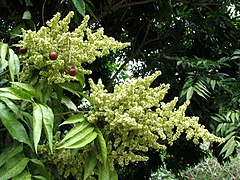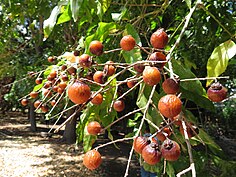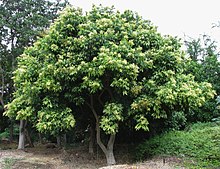bio.wikisort.org - Plant
Sapindus saponaria is a small to medium-sized deciduous tree[3] native to the Americas. Common names include wingleaf soapberry,[4] western soapberry, jaboncillo,[2] sulluku[5][6][7] and manele and a'e (Hawaiian).[8] Its genus name, "Sapindus", comes from the Latin, meaning Indian soap, and its specific epithet means "soapy."[3]
Taxonomy
Two subspecies are recognized:
- Sapindus saponaria var. drummondii (Hook. & Arn.) L.D.Benson (syn. S. drummondii Hook. & Arn.) – Western soapberry[9] native from Arizona[10] across to Louisiana in the south ranging north to Kansas and far southwestern Missouri in the north. It is also native to the states of Sonora, Chihuahua, and Coahuila in Mexico.[3]
- Sapindus saponaria var. saponaria (syn. S. marginatus Willd., S. thurstonii Rock) – Wingleaf soapberry[11] native almost exclusively to far south Florida in the United States but also occurs in an isolated area of coastal southeast Georgia. It is also found in the Caribbean, Central and South America,[2] and island of Hawaiʻi.[8]
Distribution
This species has a very wide native range throughout the Americas, ranging from Kansas (with isolated populations known as far north as Montana, Colorado, and Missouri) east to Florida and the West Indies, and south to Paraguay. Populations are also known from isolated oceanic islands, including Clarion Island, the Galápagos Islands, and the Hawaiian Islands.[1]
Description

It often grows in clumps or thickets reaching about 20 ft. (6.1 m) in height in the western part of its range. Solitary trees though can grow as tall as 50 ft. (15.2 m) in height. In the western part of its range it is most often found growing at the head of prairie ravines, the margins of woodlands, the edges of fields or on rocky hillsides.
The leaves of the soapberry are alternate, pinnately compound, thick and leathery but deciduous, 8 in. (20 cm) to 15 in. (38 cm) in length, made up of 6 to 20 narrow lanceolate leaflets with smooth margins, long tapered tips, and uneven wedge-shaped bases which are 2 in. to 5 in. (5 cm to 13 cm) long and .75 in. to 1.5 in. (2 cm to cm) wide. Midveins on leaves of var. saponaria are mostly winged, while those of var. drummondii are never winged.
The inflorescence are dense terminal panicles of small white flowers 6 in. to 10 in (15 cm to 20 cm) long. Flowering occurs in May–June for var. drummondii and in November for var. saponaria.
The fruit occur in large pyramidal clusters at the ends of branches. Each golden colored fruit is between 1.2 in. to 1.4 in. (3 cm to 3.6 cm) in diameter and becomes translucent and wrinkled when fully mature and contains a single black seed about .35 in (9 mm) in diameter. Fruits of var. drummondii ripen in October and often remain on the tree until spring, while those of var. saponaria ripen in spring. The fruits can contain as much as 37% of saponin, and when macerated in water they produce a soapy lather.[12] Formerly, they were much used in Mexico and in other regions for laundering clothes.[12]
The twigs of var. drummondii are gray-brown and hairy with short tan colored hairs while those of var. saponaria are gray and hairless. Buds on var. drummondii are small dark brown and hairy while those on var. saponaria are small brown and hairless.

The trunk of var. drummondii has light gray, scaly with thin plate like bark and sometimes shallowly furrowed while var. saponaria has gray to reddish colored scaly bark.
Uses and toxicity
The dark round seeds are made into buttons and necklaces. The wood splits easily and is made into baskets.[13]
The fruit of S. drummondii are poisonous and can cause skin rashes;[13] they have been used to stupefy fish.[14] The foliage may also be toxic to livestock.[13]
Notable specimens
- The US national champion Sapindus saponaria var. drummondii is located in southern Johnson County, Kansas and measures 59 ft. (18 m) tall, 39 ft. (11.9 m) wide crown spread with a trunk circumference of 10 1/2 ft. (3.2 m) in. at 4 1/2 ft. (1.4 m).[15]
- The US national champion Sapindus saponaria var. saponaria is located in Hawaii County, Hawaii and measures 71 ft. (21.6 m) tall, 68 ft. (20.7 m) wide crown spread with a trunk circumference of 160.5 inches (408 cm) at 4 1/2 ft. (1.4 m).[16]
References
- IUCN SSC Global Tree Specialist Group & Botanic Gardens Conservation International (BGCI) (2020). "Sapindus saponaria". IUCN Red List of Threatened Species. 2020: e.T156771087A156771089. doi:10.2305/IUCN.UK.2020-1.RLTS.T156771087A156771089.en. Retrieved 27 June 2022.
- "Sapindus saponaria". Germplasm Resources Information Network (GRIN). Agricultural Research Service (ARS), United States Department of Agriculture (USDA). Retrieved 2010-11-02.
- Matt Turner (2009). Remarkable Plants of Texas: Uncommon Accounts of Our Common Natives (Corrie Herring Hooks Series). Austin: University of Texas Press. pp. 95–97. ISBN 978-0-292-71851-7.
- USDA, NRCS (n.d.). "Sapindus saponaria". The PLANTS Database (plants.usda.gov). Greensboro, North Carolina: National Plant Data Team. Retrieved 5 November 2015.
- Hugo E. Delgado Sumar, Los recursos curativos vegetales en la medicina tradicional peruana
- Louis Girault, Kallawaya - guérisseurs itinérants des Andes. Recherches sur les pratiques médicinales et magiques. Paris 1984. p. 301. Cholokke, Sulluku (K). Sapindus saponaria
- César del Solar Meza, Rainer Hostnig (2006): Litograbados indígenas en la arquitectura colonial del Departamento del Cusco, Perú
- "Sapindus saponaria". Hawaiian Native Plant Propagation Database. University of Hawaiʻi at Mānoa. Retrieved 2010-11-02.
- "Sapindus saponaria var. drummondii". Integrated Taxonomic Information System. Retrieved 2010-11-02.
- McNair, D.M.; Andresen, S. (2020). "Soapberry (Sapindus L.) in Arizona" (PDF). Phytoneuron: 1–23.
- "Sapindus saponaria var. saponaria". Integrated Taxonomic Information System. Retrieved 2010-11-02.
- Standley, Paul C.; Blake, S. F. (1923). "Trees and Shrubs of Mexico (Oxalidaceae-Turneraceae)". Contributions from the United States National Herbarium. Washington, D.C.: Department of Botany, Smithsonian Institution. 23 (3): 709. JSTOR 23492504.
- Little, Elbert L. (1994) [1980]. The Audubon Society Field Guide to North American Trees: Western Region (Chanticleer Press ed.). Knopf. p. 543. ISBN 0394507614.
- Peattie, Donald Culross (1953). A Natural History of Western Trees. New York: Bonanza Books. p. 628.
- American Forests (2007). "Western Soapberry Record". Retrieved June 29, 2012.
- American Forests (2017). "Wingleaf Soapberry Record". Retrieved November 28, 2020.
External links
 Media related to Sapindus saponaria at Wikimedia Commons
Media related to Sapindus saponaria at Wikimedia Commons Data related to Sapindus saponaria at Wikispecies
Data related to Sapindus saponaria at Wikispecies
На других языках
[de] Waschnussbaum
Der Waschnussbaum (Sapindus saponaria), wie manch andere Pflanzenart auch Seifenbaum genannt, ist eine Pflanzenart innerhalb der Familie der Seifenbaumgewächse (Sapindaceae).[1] Sie stammt aus den tropischen und subtropischen Regionen Süd- und Mittelamerikas sowie aus der Karibik. Das wertvollste Pflanzenteil ist ihre Frucht, die seit Jahrtausenden zum Waschen verwendet wird.[2]- [en] Sapindus saponaria
[es] Sapindus saponaria
Sapindus saponaria (Michú) L. es una especie de arbolito de la familia Sapindaceae. Se encuentra especialmente en América.[ru] Мыльное дерево настоящее
Мы́льное де́рево настоя́щее, или Сапи́ндус мыльный (лат. Sapíndus saponária) — вид деревьев рода Мыльное дерево (Sapindus) семейства Сапиндовые (Sapindaceae).Другой контент может иметь иную лицензию. Перед использованием материалов сайта WikiSort.org внимательно изучите правила лицензирования конкретных элементов наполнения сайта.
WikiSort.org - проект по пересортировке и дополнению контента Википедии

